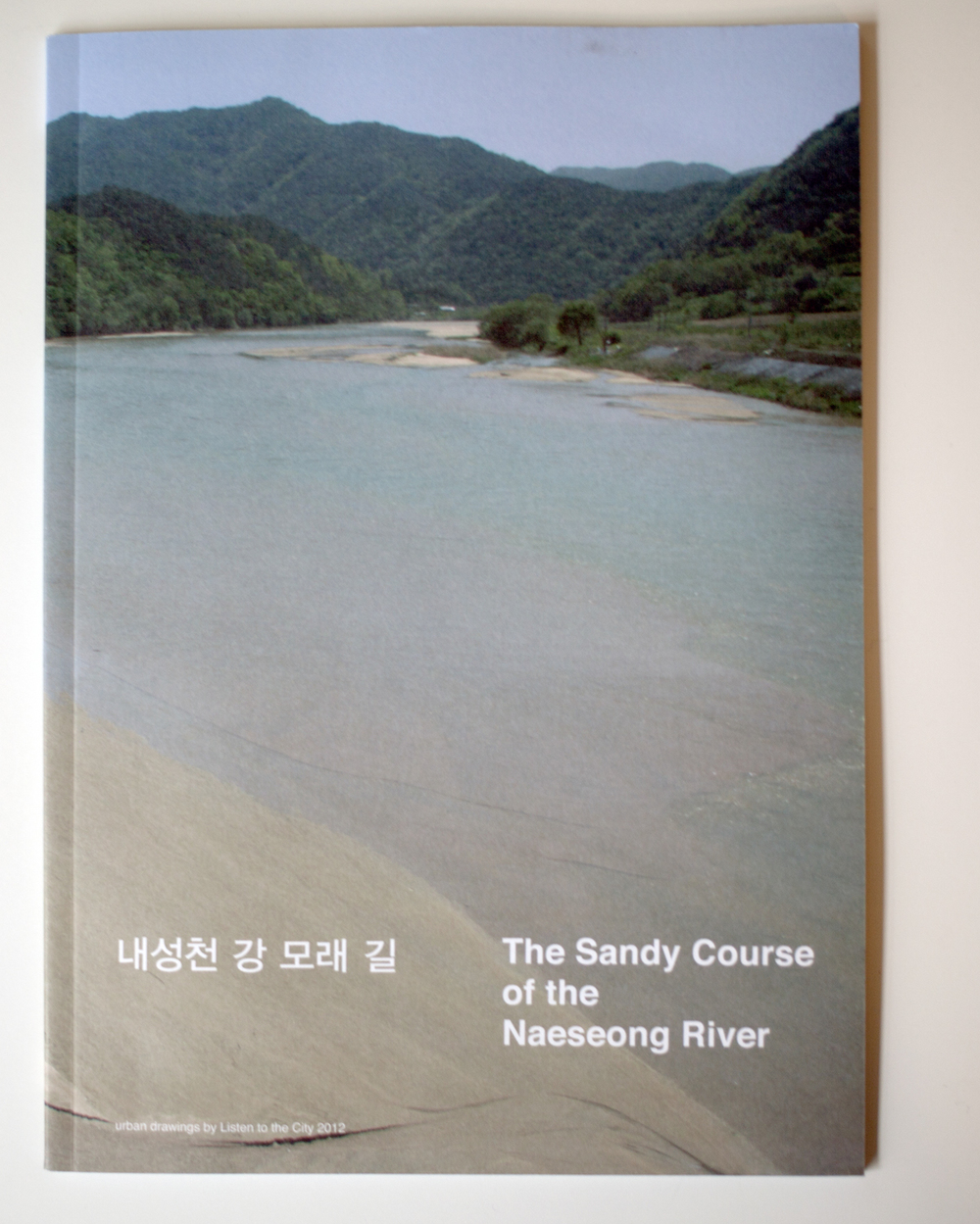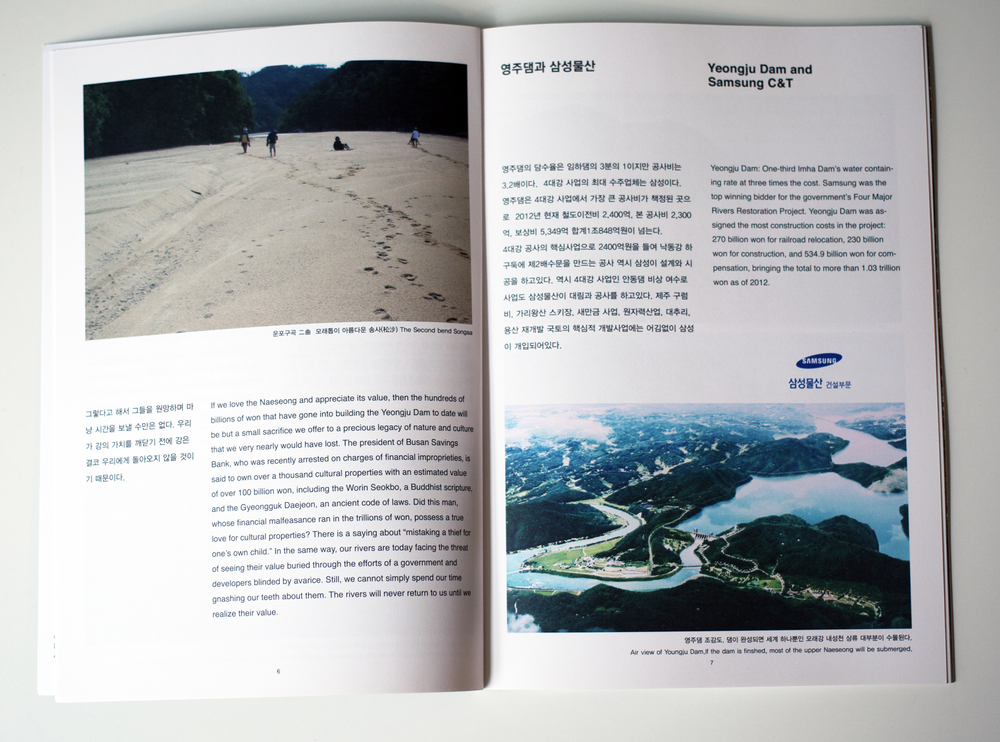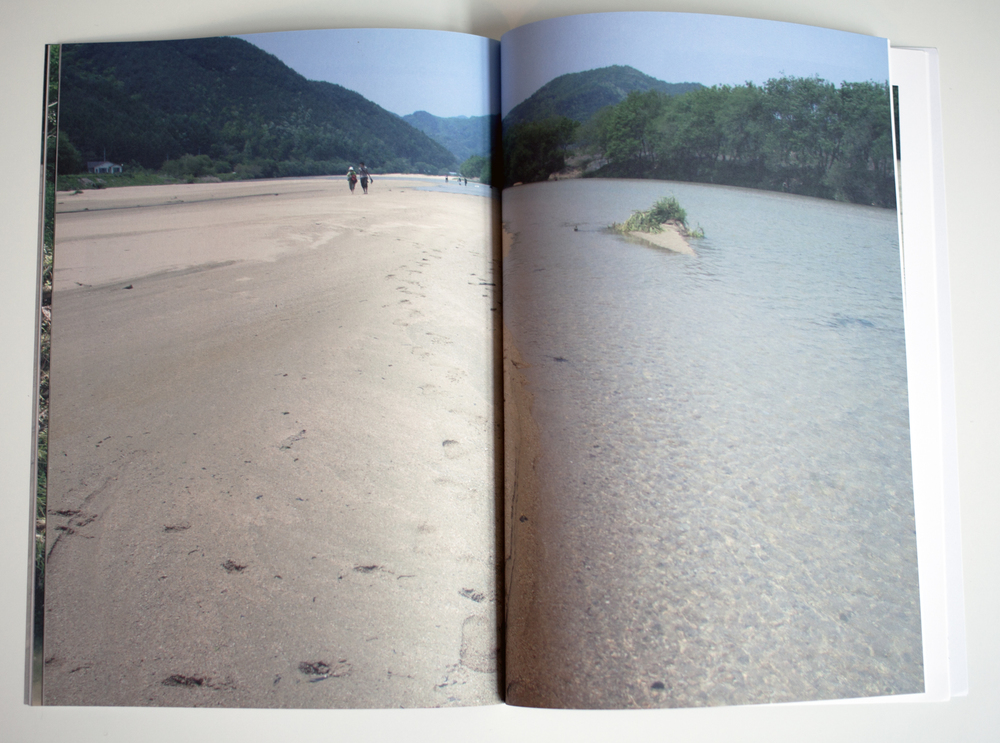Listen to the City and destruction of rivers in South Korea.
Eunseon Park and Junho Kim part of the artist collective Listen to the City—from Seoul, Korea—recently gave a presentation about their work at the Nørrebro art space, Itinerant Sends for Itinerant. The pair is part of the larger Listen to the City group–artists, designers and filmmakers working mainly in Seoul, who produce critical, artistic commentary on the neoliberal city, problems with public sculpture, unfair labor practices, and environmental effects of short sighted urban planning. A main Listen to the City project is a magazine by the same name focused on art, architecture and urbanism. According to Eunseon the group tries not to take government funding for the art and activist work they do, because it could compromise the integrity of their ideas. Eunseon explained that Listen to the City is critical of the role large corporations, like Samsung, have played in shaping the landscape of public space in Korea. She discussed the problems small business owners and homeowners in Seoul have experienced when developments are planned with corporate interests in mind. Listen to the City participates and documents the struggles happening around urban planning within Seoul.
The group does not stop within the boundaries of the city however. The most moving part of her presentation was Eunseon’s discussion of the work Listen to the City has been doing around the environmental tragedy currently happening along Korea’s Naesong River.

The Sandy Course of the Naesong River, documents the ongoing research conducted by Listen to the City in to the Four Major Rivers project, which according to Eunseon, was spearheaded to support the construction industry in Korea, struggling after the financial collapse, in building dams along the Naesong River. Through photography, documentary film, and interviews, Listen to the City has created a portrait of an ecosystem on the brink of destruction. The group made a book based on their research, which is in both Korean and English, an important feature says Eunseon for spreading the story of what is happening outside of Korea.
So what is happening? The Listen to the City book (which can be read on line here) focuses on dam building projects on the Naesong River, a primary tributary of the Nakdong River. Eunseon explains that the river is both an important source of drinking water for Korea and the home of many diverse species of wildlife, including the Mandarin Duck, the rare Black head stork, and the otter (an endangered species). According to her presentation and the book, the Samsung Corporation won a government contract to build a dam, Yeongju Dam, as of 2012. This dam and subsidiary construction projects associated with it, would reduce the flow of water on the Naesong River, drastically shifting ecosystems and endangering both drinking water and wildlife. Eunseon explains that parks and other developments are planned for the area after the rivers have been drained. Listen to the City has been making documentaries, activist, and art projects, as well as a Tent School on the banks of the Naesong to raise awareness in Korea around the potential ecological disaster. The group has created a mobile exhibition showing their work around Seoul. Eunseon laments that many people in the city are not aware of what is happening to the environment in the countryside.

The book documents a love of the river through poetic writing and a brief history of the human relationship with the river. Willow trees and rice farms have been cultivated along the river, sustaining Korean families and farmers for centuries. The area of Yeongju, where the dam is planned, was once known as ‘the nine bends of cloud hung river,’ because of its winding beauty with 9 distinct landscapes.
Listen to the City, through various media strategies, and visual culture paint a compelling picture of why this integral ecosystem should be saved. It is a story that garners few headlines outside of Korea. Thanks to Eunseon, Junho, and Listen to the City for sharing this important story in Copenhagen.

Radio Aktiv Sonic Deep Map (2013)

SUPERKILEN – Extreme Neoliberalism Copenhagen Style

Read Brett's essay about the park.
Download our guide:

This is our guide to how-to books from the counterculture of the 60s and 70s. Click to get the download page.
Categories
- Agriculture (11)
- Animal sounds (1)
- Artist parents (19)
- Arts and culture (106)
- Bees (3)
- Book reviews (14)
- Books (18)
- Critical essays (5)
- Daily Photo (5)
- Design (36)
- Dirt (11)
- Environmental activism (43)
- Exhibitions (24)
- Farms (11)
- Forest (7)
- Friday connect (15)
- Growing (42)
- Habitat (38)
- Homesteading (16)
- Interviews (15)
- Kitchen (14)
- Living structure (9)
- MISC (15)
- Mythological (2)
- Neighborhood (83)
- Ocean News (1)
- Our Art Work (21)
- Personal – Design/Art (3)
- Play (2)
- Playground (4)
- Projects (21)
- Public space (53)
- Resilience (13)
- Sea Side (2)
- Sojabønner (2)
- Tofu (8)
- Vermont correspondence (7)
- Water (3)
- Wednesday picture (31)
- Workshop (1)
Video interview:

Watch our interview of SeedBroadcast, a mobile project that is part seed library and part seed-saving-story-collecting machine-recording the stories of seed saving, farming, and food sovereignty work being done around the US.

Download a poster Bonnie made about biodiversity in a vacant lot in the Amager borough of Copenhagen, in collaboration with biologist, Inger Kærgaard, ornithologist, Jørn Lennart Larsen and botanist, Camilla Sønderberg Brok: A BRIEF TAXONOMY OF A LOT

We made and installed a network of bat houses in Urbana, Illinois, to support the local and regional bat population, but also to begin a conversation about re-making the built environment.
READ MORE
BOOK REVIEW:

We write often about artists and art groups that work with putting ‘culture’ back in agriculture. Here is a new favorite: myvillages, a group of three women based in Germany, the Netherlands, and the UK. Read more...

Post Revolutionary Exercises
We really admire the dedicated hard work of Kultivator who seeks to fuse agriculture and art in their work. Click this sentence to get a PDF of their poster collection called "Post Revolutionary Exercises."

Cultural Practices Within And Across
This amazing book networks urban and rural resilience and sustainability projects around the world. Deeply inspiring projects in Romania, Paris, San Francisco, and elsewhere.
• Read our review of the book.
• Buy the book.
• Download the book.







